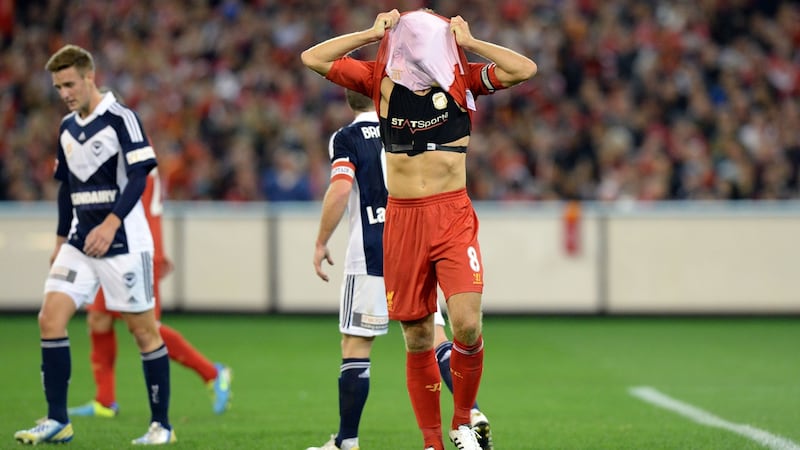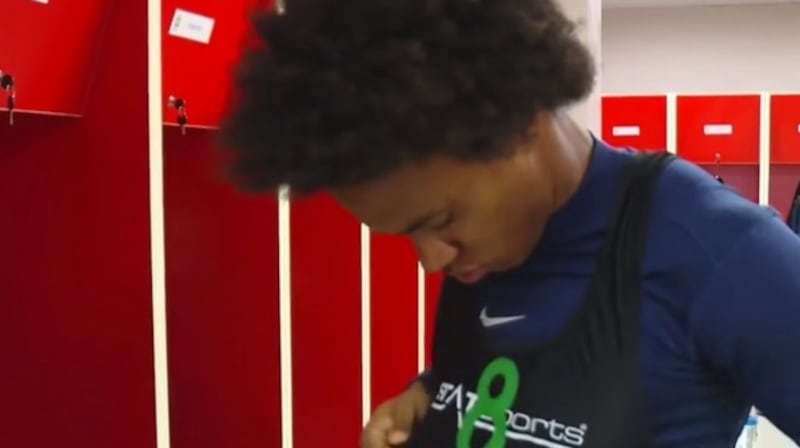Talk to any company bigwig and they’ll happily bang on about how the staff make their business. Some of them even believe it. Few speak about it with as much no-nonsense conviction as Sean O’Connor, co-founder of Irish sports technology firm StatSports.
“When we send someone into a club, then as far as that team is concerned, he is StatSports. So if he’s an arsehole, then by extension we all are,” is how he puts it when outlining the need to have the right people working for the company.
Performance is everything, as you’d expect from a company whose business is making and selling performance tracking GPS systems and software to some of the most elite sports stars globally.
StatSports technology is used by 1,500 sports teams globally, so it seems the company’s representatives are managing not to come over as too star-struck.
"You can't go into clubs drooling all over the players or pandering to them," adds O'Connor, recounting how he and co-founder Allan Clarke once found themselves in the middle of the Irish rugby team's dressing room with the latter bellowing out for Keith Earls to make himself known so he could be fitted with the company's device ahead of a crunch match.

StatSports isn’t quite as well-known as its clients, but the formerly media-shy company has been making plenty of headlines of its own of late.
Founded by Clarke and O'Connor a decade ago, StatSports supplies its technology to many leading European soccer clubs including Liverpool, Arsenal, Manchester City, Manchester United, Barcelona and Juventus. The company's monitoring devices are also used by the Irish Rugby Football Union (IRFU) and all four Irish rugby provinces, as well as teams playing across GAA, American football, hockey and basketball.
US soccer deal
The Newry-headquartered group earlier this year scored a whopping £1 billion (€1.1bn) deal with the US Soccer Federation in what is believed to be the biggest contract ever signed in the elite sports wearables market.
It followed this up with a second big deal to supply its monitoring devices to the Brazilian national football squad during the World Cup. Other nations using the technology during this year’s finals in Russia included Germany, Portugal, Belgium, England, Poland, Denmark and Morocco.
StatSports has developed a device that can be worn in a vest and positioned between the shoulder blades during training and matches. It measures and analyses physical attributes of players and can provide feedback on metrics – such as distance and speed, as well as levels of fatigue and injury risk. The information gathered can be streamed directly to a phone, tablet or smartwatch, making it easy for coaches to incorporate it into training schedules.
Earlier this month, the company announced the release of a monitoring device – its first for the consumer market. The new Apex Athlete Series allows amateur athletes to use the same technology as that worn by soccer stars such as Ronaldo, Neymar and Pogba to track their performance.
O’Connor describes the move as a “game-changer” – both for the company and the consumer sports device market.
“The aim from the very beginning has been to bring the technology to the consumer market and it is rewarding to finally have it out there,” he says, sitting back in his chair in the new boardroom at StatSports HQ near the Quays shopping centre in Newry. “But now the real work begins.”
“I can’t even begin to estimate how big the potential market is for us because, as we see it, anyone who changes their clothes to go and exercise is someone who is taking their performance seriously. That makes them a potential customer,” he adds.
The company is certainly in training for the big time. It recently moved into a second floor of the building in which it is based and is expecting to take on additional staff and potentially outside investment as it looks to make the most of new opportunities.
Despite being founded in the middle of a global financial crisis, StatSports has enjoyed consistent year-on-year growth in turnover over the past decade and has been profitable since the get-go. In 2017, the business doubled its turnover on the previous year and recorded a profit before tax of €1.4million. It currently employs more than 50 people.
The growth has all been self-funded. It has never taken on bank debt or outside investment. Profits have been reinvested continually in research and development.
Sideline inspiration
“The software is never finalised. It is continually being refined and so we haven’t ever really reached a point where we feel like we can sit back and rest. In the first few years, neither Alan or I took any wages. And then, after that, we realised that we needed to build a war chest to keep on with the R&D and things have continued like that,” says O’Connor.

Dressed, like pretty much all his colleagues, in casual sporting attire, the entrepreneur could still be a sports scientist. Having grown up in Bellurgan, near Dundalk, with dreams of becoming a superstar footballer, O'Connor initially studied sports science at UWIC (now Cardiff Metropolitan University) in Wales before specialising in sporting injuries at Sheffield Hallam University.
Returning to live in Ireland where opportunities were few and far between in the elite sports space, he was looking at a potential career as a gym teacher before a conversation on the terraces changed everything.
“I was watching a local soccer match in the Meath and District League and talking to someone about how more teams should use fitness testing equipment. Alan piped up beside us and joined in the conversation. I knew him a bit because he was managing a local team at the time, but I was still surprised when the next day I got a call from him telling me he’d been pricing the equipment,” says O’Connor.
“He’s called me pretty much every day since then,” he adds, referring to the former musician and engineer, who briefly enters the room (dressed in a Run DMC t-shirt and tracksuit trousers) to say hello before scarpering off ahead of the photographer’s arrival.
O’Connor admits that the company was hardly the first to come up with technology to measure fitness levels. But it was early days for the tech, and very few sports clubs were using it at that stage.
“Our idea initially was to establish an all-encompassing sports science company that would go to clubs that didn’t have big budgets and say that we had the technology that elite clubs were using and could come in and run tests for them.
“It was only after we’d sourced the tech and went out with it that we realised that actually most of the big clubs weren’t actually using the solutions we had,” he says.
Turning point
While the company has achieved great success, O'Connor stresses that it has come in increments. A key turning point came after it started working with the Leinster rugby side during the period in which it won the Heineken Cup final for the first time. This drew other clubs, both across rugby and in other sports to contact the company to find out more about what they were doing.
O’Connor says that, with teams spending so much on athletes and players, being able to monitor them to ensure they stay match fit for longer is critical. Not surprisingly, it found an eager audience for its products.
Initially, the company was using technology developed by other companies. Another key turning point for it was when it began investing in its own tech solutions.
"The first real big leap for us, as a company, was when we brought out the Viper system in 2012, which we'd done after collaborating with the likes of Dundalk Institute of Technology and following talks with a lot of big clubs about what they were looking for," says O'Connor.
The company’s technology has developed substantially over the years as has take-up by teams across the globe.
“When we started out, we were going into clubs and trying to teach them how the technology worked by pointing up at satellites in the sky. But teams increasingly know what we do now, although you’d be surprised how many opportunities there still are in some sports,” says O’Connor.
“It wasn’t just about the tech though. While some sports guys might want to see raw Excel data on players, the manager just wants to be able to consult his iPad and maybe see just a few easy-to-read metrics,” he adds.
O’Connor says that initially the goal was to make sure teams had data before the players were out of the showers. Now they can get it in real-time at the side of the pitch.
Biggest rival
“What we’re doing isn’t rocket science and, while we might have had to explain concepts like GPS and sat navs early on, now we are part and parcel of the kit. You put on your shirt, your shorts, your shin guards and your monitoring device and you head out to play,” he says.

StatSports doesn't have the field completely to itself. Its biggest rival is Catapult, an Australian-listed giant with revenues of 61.89 million Australian dollars (€39.5 million) last year. When StatSports won the Brazilian football deal recently, it did so by convincing the Brazilian Football Confederation to ditch Catapult.
“We’re very confident that what we are doing now is very far ahead of our competitors and that we’ve some impressive stuff in the pipeline,” says O’Connor. “We never had a big masterplan that had to be faithfully executed. I’d say we are unlikely entrepreneurs so we have had to put more of a strategy in place in recent years as we’ve grown.”
The company intends to keep its headquarters in Newry, with O’Connor saying that being Irish has been helpful to winning business with elite sports clubs. As outsiders, StatSports is seen as neutral.
“Success in this industry is very much built on relationships which is why it important that we employ the right people. The sporting world might be massive but there are only a small number of elite clubs and the people there all know each other. Word-of-mouth and reputation is everything. It is still extremely hard work getting into the elites and we have to make sure that when we do, that we say the right thing,” O’Connor says.
CV
Name: Sean O'Connor
Position: Co-founder and chief operations officer of sports technology company StatSports
Age: 36
From: Bellurgan, Co Louth
Family: Married to Maria, they have two children – one aged 4, the other one week old.
Favourite sports club: NFL side Carolina Panthers
Oddest professional moment: When Manuel Pellegrino introduced himself on his first day as Manchester City manager, thinking Sean was a member of the staff
Something you might expect: Sean wanted to be a professional footballer when he was younger
Something that might surprise: "I can't really watch a Premier League game all the way through any more. I analyse everything too much so I can't just sit and enjoy it."













